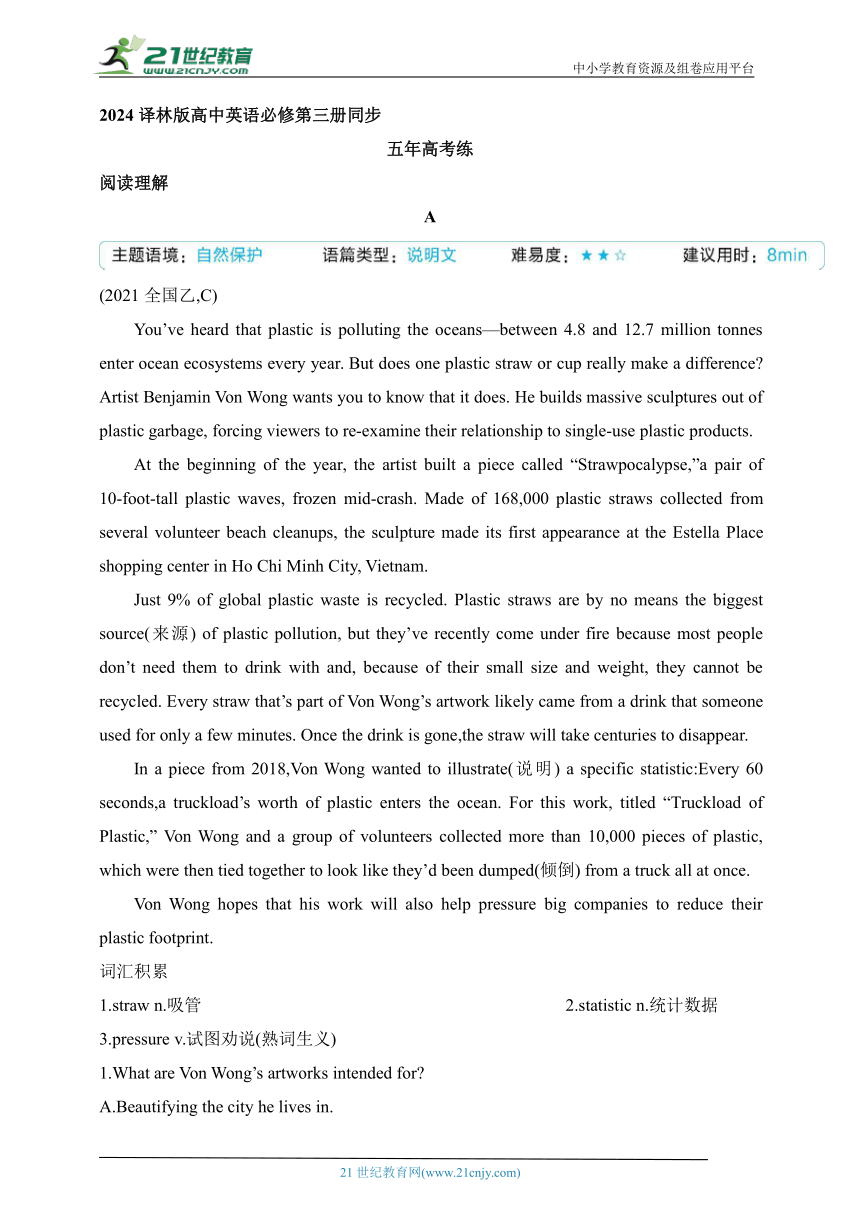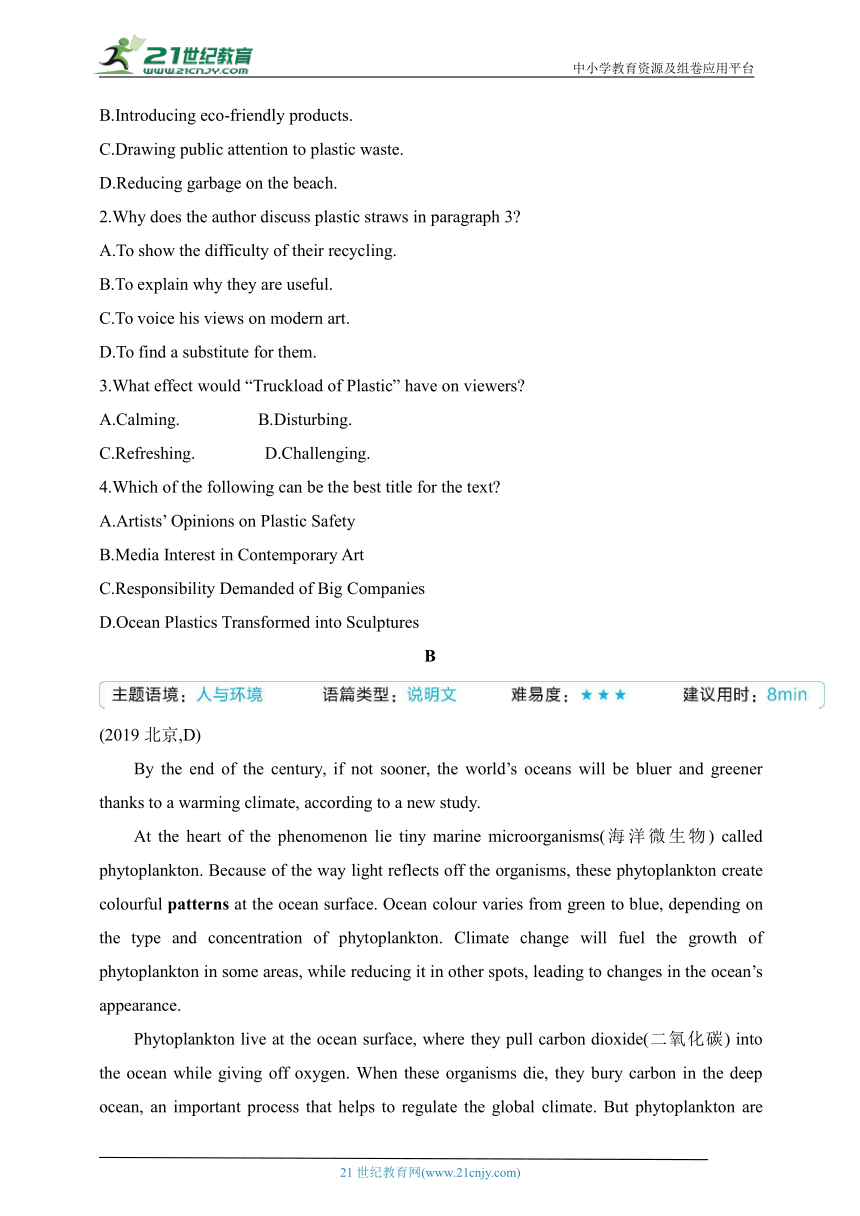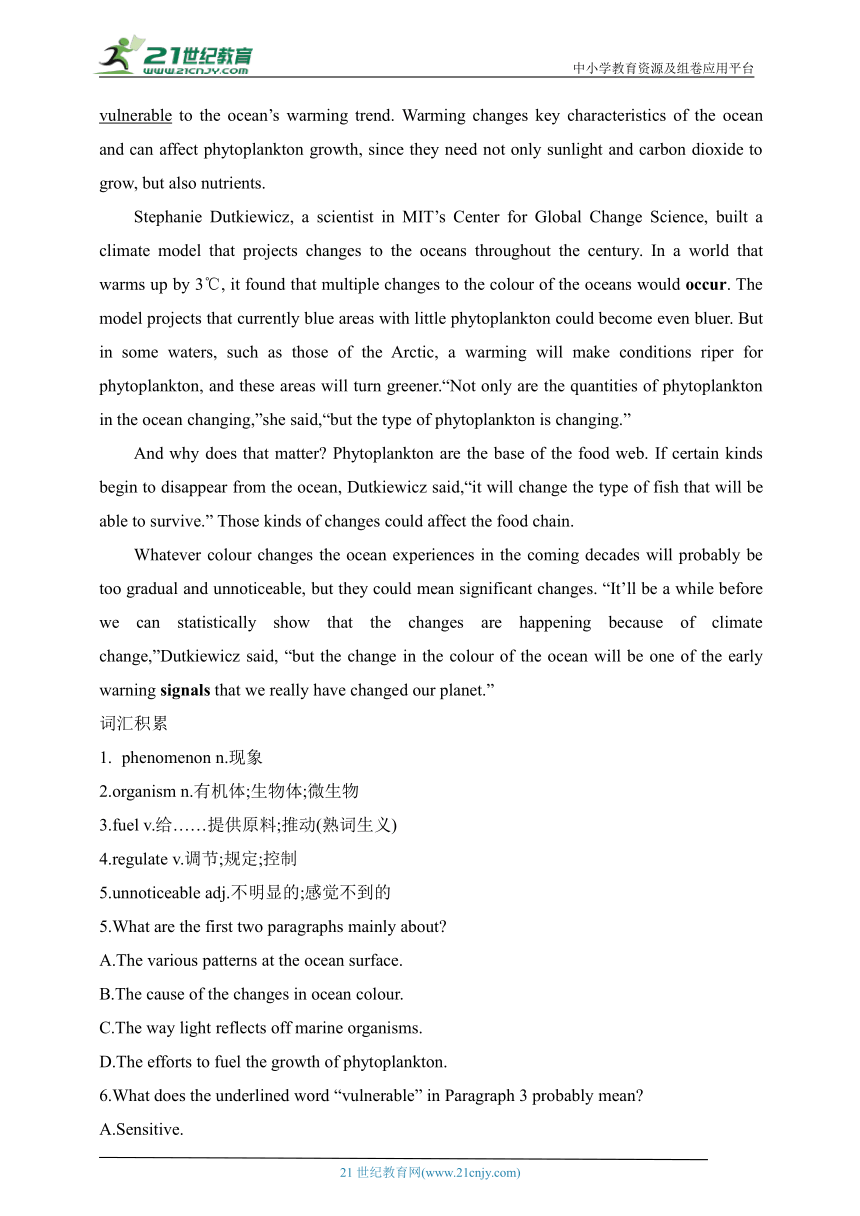2024译林版高中英语必修第三册同步练习--Unit 2 五年高考练
文档属性
| 名称 | 2024译林版高中英语必修第三册同步练习--Unit 2 五年高考练 |  | |
| 格式 | docx | ||
| 文件大小 | 1011.3KB | ||
| 资源类型 | 试卷 | ||
| 版本资源 | 牛津译林版(2019) | ||
| 科目 | 英语 | ||
| 更新时间 | 2023-11-13 15:16:40 | ||
图片预览



文档简介
中小学教育资源及组卷应用平台
2024译林版高中英语必修第三册同步
五年高考练
阅读理解
A
(2021全国乙,C)
You’ve heard that plastic is polluting the oceans—between 4.8 and 12.7 million tonnes enter ocean ecosystems every year. But does one plastic straw or cup really make a difference Artist Benjamin Von Wong wants you to know that it does. He builds massive sculptures out of plastic garbage, forcing viewers to re-examine their relationship to single-use plastic products.
At the beginning of the year, the artist built a piece called “Strawpocalypse,”a pair of 10-foot-tall plastic waves, frozen mid-crash. Made of 168,000 plastic straws collected from several volunteer beach cleanups, the sculpture made its first appearance at the Estella Place shopping center in Ho Chi Minh City, Vietnam.
Just 9% of global plastic waste is recycled. Plastic straws are by no means the biggest source(来源) of plastic pollution, but they’ve recently come under fire because most people don’t need them to drink with and, because of their small size and weight, they cannot be recycled. Every straw that’s part of Von Wong’s artwork likely came from a drink that someone used for only a few minutes. Once the drink is gone,the straw will take centuries to disappear.
In a piece from 2018,Von Wong wanted to illustrate(说明) a specific statistic:Every 60 seconds,a truckload’s worth of plastic enters the ocean. For this work, titled “Truckload of Plastic,” Von Wong and a group of volunteers collected more than 10,000 pieces of plastic, which were then tied together to look like they’d been dumped(倾倒) from a truck all at once.
Von Wong hopes that his work will also help pressure big companies to reduce their plastic footprint.
词汇积累
1.straw n.吸管 2.statistic n.统计数据
3.pressure v.试图劝说(熟词生义)
1.What are Von Wong’s artworks intended for
A.Beautifying the city he lives in.
B.Introducing eco-friendly products.
C.Drawing public attention to plastic waste.
D.Reducing garbage on the beach.
2.Why does the author discuss plastic straws in paragraph 3
A.To show the difficulty of their recycling.
B.To explain why they are useful.
C.To voice his views on modern art.
D.To find a substitute for them.
3.What effect would “Truckload of Plastic” have on viewers
A.Calming. B.Disturbing.
C.Refreshing. D.Challenging.
4.Which of the following can be the best title for the text
A.Artists’ Opinions on Plastic Safety
B.Media Interest in Contemporary Art
C.Responsibility Demanded of Big Companies
D.Ocean Plastics Transformed into Sculptures
B
(2019北京,D)
By the end of the century, if not sooner, the world’s oceans will be bluer and greener thanks to a warming climate, according to a new study.
At the heart of the phenomenon lie tiny marine microorganisms(海洋微生物) called phytoplankton. Because of the way light reflects off the organisms, these phytoplankton create colourful patterns at the ocean surface. Ocean colour varies from green to blue, depending on the type and concentration of phytoplankton. Climate change will fuel the growth of phytoplankton in some areas, while reducing it in other spots, leading to changes in the ocean’s appearance.
Phytoplankton live at the ocean surface, where they pull carbon dioxide(二氧化碳) into the ocean while giving off oxygen. When these organisms die, they bury carbon in the deep ocean, an important process that helps to regulate the global climate. But phytoplankton are vulnerable to the ocean’s warming trend. Warming changes key characteristics of the ocean and can affect phytoplankton growth, since they need not only sunlight and carbon dioxide to grow, but also nutrients.
Stephanie Dutkiewicz, a scientist in MIT’s Center for Global Change Science, built a climate model that projects changes to the oceans throughout the century. In a world that warms up by 3℃, it found that multiple changes to the colour of the oceans would occur. The model projects that currently blue areas with little phytoplankton could become even bluer. But in some waters, such as those of the Arctic, a warming will make conditions riper for phytoplankton, and these areas will turn greener.“Not only are the quantities of phytoplankton in the ocean changing,”she said,“but the type of phytoplankton is changing.”
And why does that matter Phytoplankton are the base of the food web. If certain kinds begin to disappear from the ocean, Dutkiewicz said,“it will change the type of fish that will be able to survive.” Those kinds of changes could affect the food chain.
Whatever colour changes the ocean experiences in the coming decades will probably be too gradual and unnoticeable, but they could mean significant changes. “It’ll be a while before we can statistically show that the changes are happening because of climate change,”Dutkiewicz said, “but the change in the colour of the ocean will be one of the early warning signals that we really have changed our planet.”
词汇积累
phenomenon n.现象
2.organism n.有机体;生物体;微生物
3.fuel v.给……提供原料;推动(熟词生义)
4.regulate v.调节;规定;控制
5.unnoticeable adj.不明显的;感觉不到的
5.What are the first two paragraphs mainly about
A.The various patterns at the ocean surface.
B.The cause of the changes in ocean colour.
C.The way light reflects off marine organisms.
D.The efforts to fuel the growth of phytoplankton.
6.What does the underlined word “vulnerable” in Paragraph 3 probably mean
A.Sensitive.
B.Beneficial.
C.Significant.
D.Unnoticeable.
7.What can we learn from the passage
A.Phytoplankton play a declining role in the marine ecosystem.
B.Dutkiewicz’s model aims to project phytoplankton changes.
C.Phytoplankton have been used to control global climate.
D.Oceans with more phytoplankton may appear greener.
8.What is the main purpose of the passage
A.To assess the consequences of ocean colour changes.
B.To analyse the composition of the ocean food chain.
C.To explain the effects of climate change on oceans.
D.To introduce a new method to study phytoplankton.
答案与分层梯度式解析
五年高考练
A
◎语篇解读 本文为说明文。文章介绍了Benjamin Von Wong为倡导环保而把塑料废物做成艺术品,用有趣的方式呼吁人们关爱我们的地球。
1.C 推理判断题。根据第一段中的“He builds massive...forcing viewers to re-examine their relationship to single-use plastic products.”可知Von Wong 把塑料废物制成了雕塑,让看到雕塑的人重新审视他们和一次性塑料产品之间的关系,以达到让人们关注塑料污染问题的目的。
2.A 推理判断题。根据第三段第一句“Just 9% of global plastic waste is recycled.”及第二句的“because of their small size and weight, they cannot be recycled”可知,全球只有9%的塑料废品被回收利用,吸管因小而且轻不能被回收利用。故选A。
3.B 推理判断题。根据倒数第二段中的“In a piece...a specific statistic: Every 60 seconds,a truckload’s worth of plastic enters the ocean.”可知,Von Wong 想用“Truckload of Plastic”这件作品说明每60秒就有一卡车的量的塑料被倒入海洋,以引起人们的担忧。
4.D 主旨大意题。文章介绍Von Wong把污染海洋的塑料垃圾制成艺术品,唤醒人们对一次性塑料制品的关注,提高人们的环保意识。因此D项“海洋塑料变成了雕塑”最适合作为文章标题。
长难句 原句 For this work, titled “Truckload of Plastic,”Von Wong and a group of volunteers collected more than 10,000 pieces of plastic, which were then tied together to look like they’d been dumped from a truck all at once.
分析 这是一个主从复合句。“titled...”为过去分词短语作定语,修饰work;which引导非限制性定语从句,修饰先行词 more than 10,000 pieces of plastic,关系词在从句中作主语;were tied是从句中的谓语。
译文 为了这个名为“Truckload of Plastic”的作品,Von Wong和一群志愿者收集了一万多片塑料,然后把它们捆在一起,看起来就像从卡车上一下子被倾倒下来。
B
◎语篇解读 本文是一篇说明文。气候变暖导致了海洋浮游植物的变化,进而会影响海洋颜色的变化。
5.B 主旨大意题。文章第一段给出了海洋颜色变化的原因,第二段具体说明了海洋颜色变化的原因在于海洋浮游植物的类型和浓度的变化。综上所述,前两段主要说明了海洋颜色变化的原因,故选B项。
6.A 词义猜测题。根据下文可知气候变暖改变了海洋的主要特点,影响了浮游植物的生长,结合关键词changes和affect可综合推断出浮游植物对海洋变暖的趋势是比较敏感的,故选A项(敏感的)。B:有益的;C:重大的;D:不被注意的。
7.D 推理判断题。根据第四段中的“But in some waters...a warming will make conditions riper for phytoplankton, and these areas will turn greener.”可知,在更适宜浮游植物生长的地方,海洋会变得更绿,故选D项(有更多浮游植物的海洋可能看上去更绿)。
8.C 推理判断题。根据全文,尤其是中心段落第一段中的“the world’s oceans will be bluer and greener thanks to a warming climate”可知,文章的主要目的是解释气候变化对海洋尤其是其颜色的影响,故选C项。
21世纪教育网 www.21cnjy.com 精品试卷·第 2 页 (共 2 页)
21世纪教育网(www.21cnjy.com)
2024译林版高中英语必修第三册同步
五年高考练
阅读理解
A
(2021全国乙,C)
You’ve heard that plastic is polluting the oceans—between 4.8 and 12.7 million tonnes enter ocean ecosystems every year. But does one plastic straw or cup really make a difference Artist Benjamin Von Wong wants you to know that it does. He builds massive sculptures out of plastic garbage, forcing viewers to re-examine their relationship to single-use plastic products.
At the beginning of the year, the artist built a piece called “Strawpocalypse,”a pair of 10-foot-tall plastic waves, frozen mid-crash. Made of 168,000 plastic straws collected from several volunteer beach cleanups, the sculpture made its first appearance at the Estella Place shopping center in Ho Chi Minh City, Vietnam.
Just 9% of global plastic waste is recycled. Plastic straws are by no means the biggest source(来源) of plastic pollution, but they’ve recently come under fire because most people don’t need them to drink with and, because of their small size and weight, they cannot be recycled. Every straw that’s part of Von Wong’s artwork likely came from a drink that someone used for only a few minutes. Once the drink is gone,the straw will take centuries to disappear.
In a piece from 2018,Von Wong wanted to illustrate(说明) a specific statistic:Every 60 seconds,a truckload’s worth of plastic enters the ocean. For this work, titled “Truckload of Plastic,” Von Wong and a group of volunteers collected more than 10,000 pieces of plastic, which were then tied together to look like they’d been dumped(倾倒) from a truck all at once.
Von Wong hopes that his work will also help pressure big companies to reduce their plastic footprint.
词汇积累
1.straw n.吸管 2.statistic n.统计数据
3.pressure v.试图劝说(熟词生义)
1.What are Von Wong’s artworks intended for
A.Beautifying the city he lives in.
B.Introducing eco-friendly products.
C.Drawing public attention to plastic waste.
D.Reducing garbage on the beach.
2.Why does the author discuss plastic straws in paragraph 3
A.To show the difficulty of their recycling.
B.To explain why they are useful.
C.To voice his views on modern art.
D.To find a substitute for them.
3.What effect would “Truckload of Plastic” have on viewers
A.Calming. B.Disturbing.
C.Refreshing. D.Challenging.
4.Which of the following can be the best title for the text
A.Artists’ Opinions on Plastic Safety
B.Media Interest in Contemporary Art
C.Responsibility Demanded of Big Companies
D.Ocean Plastics Transformed into Sculptures
B
(2019北京,D)
By the end of the century, if not sooner, the world’s oceans will be bluer and greener thanks to a warming climate, according to a new study.
At the heart of the phenomenon lie tiny marine microorganisms(海洋微生物) called phytoplankton. Because of the way light reflects off the organisms, these phytoplankton create colourful patterns at the ocean surface. Ocean colour varies from green to blue, depending on the type and concentration of phytoplankton. Climate change will fuel the growth of phytoplankton in some areas, while reducing it in other spots, leading to changes in the ocean’s appearance.
Phytoplankton live at the ocean surface, where they pull carbon dioxide(二氧化碳) into the ocean while giving off oxygen. When these organisms die, they bury carbon in the deep ocean, an important process that helps to regulate the global climate. But phytoplankton are vulnerable to the ocean’s warming trend. Warming changes key characteristics of the ocean and can affect phytoplankton growth, since they need not only sunlight and carbon dioxide to grow, but also nutrients.
Stephanie Dutkiewicz, a scientist in MIT’s Center for Global Change Science, built a climate model that projects changes to the oceans throughout the century. In a world that warms up by 3℃, it found that multiple changes to the colour of the oceans would occur. The model projects that currently blue areas with little phytoplankton could become even bluer. But in some waters, such as those of the Arctic, a warming will make conditions riper for phytoplankton, and these areas will turn greener.“Not only are the quantities of phytoplankton in the ocean changing,”she said,“but the type of phytoplankton is changing.”
And why does that matter Phytoplankton are the base of the food web. If certain kinds begin to disappear from the ocean, Dutkiewicz said,“it will change the type of fish that will be able to survive.” Those kinds of changes could affect the food chain.
Whatever colour changes the ocean experiences in the coming decades will probably be too gradual and unnoticeable, but they could mean significant changes. “It’ll be a while before we can statistically show that the changes are happening because of climate change,”Dutkiewicz said, “but the change in the colour of the ocean will be one of the early warning signals that we really have changed our planet.”
词汇积累
phenomenon n.现象
2.organism n.有机体;生物体;微生物
3.fuel v.给……提供原料;推动(熟词生义)
4.regulate v.调节;规定;控制
5.unnoticeable adj.不明显的;感觉不到的
5.What are the first two paragraphs mainly about
A.The various patterns at the ocean surface.
B.The cause of the changes in ocean colour.
C.The way light reflects off marine organisms.
D.The efforts to fuel the growth of phytoplankton.
6.What does the underlined word “vulnerable” in Paragraph 3 probably mean
A.Sensitive.
B.Beneficial.
C.Significant.
D.Unnoticeable.
7.What can we learn from the passage
A.Phytoplankton play a declining role in the marine ecosystem.
B.Dutkiewicz’s model aims to project phytoplankton changes.
C.Phytoplankton have been used to control global climate.
D.Oceans with more phytoplankton may appear greener.
8.What is the main purpose of the passage
A.To assess the consequences of ocean colour changes.
B.To analyse the composition of the ocean food chain.
C.To explain the effects of climate change on oceans.
D.To introduce a new method to study phytoplankton.
答案与分层梯度式解析
五年高考练
A
◎语篇解读 本文为说明文。文章介绍了Benjamin Von Wong为倡导环保而把塑料废物做成艺术品,用有趣的方式呼吁人们关爱我们的地球。
1.C 推理判断题。根据第一段中的“He builds massive...forcing viewers to re-examine their relationship to single-use plastic products.”可知Von Wong 把塑料废物制成了雕塑,让看到雕塑的人重新审视他们和一次性塑料产品之间的关系,以达到让人们关注塑料污染问题的目的。
2.A 推理判断题。根据第三段第一句“Just 9% of global plastic waste is recycled.”及第二句的“because of their small size and weight, they cannot be recycled”可知,全球只有9%的塑料废品被回收利用,吸管因小而且轻不能被回收利用。故选A。
3.B 推理判断题。根据倒数第二段中的“In a piece...a specific statistic: Every 60 seconds,a truckload’s worth of plastic enters the ocean.”可知,Von Wong 想用“Truckload of Plastic”这件作品说明每60秒就有一卡车的量的塑料被倒入海洋,以引起人们的担忧。
4.D 主旨大意题。文章介绍Von Wong把污染海洋的塑料垃圾制成艺术品,唤醒人们对一次性塑料制品的关注,提高人们的环保意识。因此D项“海洋塑料变成了雕塑”最适合作为文章标题。
长难句 原句 For this work, titled “Truckload of Plastic,”Von Wong and a group of volunteers collected more than 10,000 pieces of plastic, which were then tied together to look like they’d been dumped from a truck all at once.
分析 这是一个主从复合句。“titled...”为过去分词短语作定语,修饰work;which引导非限制性定语从句,修饰先行词 more than 10,000 pieces of plastic,关系词在从句中作主语;were tied是从句中的谓语。
译文 为了这个名为“Truckload of Plastic”的作品,Von Wong和一群志愿者收集了一万多片塑料,然后把它们捆在一起,看起来就像从卡车上一下子被倾倒下来。
B
◎语篇解读 本文是一篇说明文。气候变暖导致了海洋浮游植物的变化,进而会影响海洋颜色的变化。
5.B 主旨大意题。文章第一段给出了海洋颜色变化的原因,第二段具体说明了海洋颜色变化的原因在于海洋浮游植物的类型和浓度的变化。综上所述,前两段主要说明了海洋颜色变化的原因,故选B项。
6.A 词义猜测题。根据下文可知气候变暖改变了海洋的主要特点,影响了浮游植物的生长,结合关键词changes和affect可综合推断出浮游植物对海洋变暖的趋势是比较敏感的,故选A项(敏感的)。B:有益的;C:重大的;D:不被注意的。
7.D 推理判断题。根据第四段中的“But in some waters...a warming will make conditions riper for phytoplankton, and these areas will turn greener.”可知,在更适宜浮游植物生长的地方,海洋会变得更绿,故选D项(有更多浮游植物的海洋可能看上去更绿)。
8.C 推理判断题。根据全文,尤其是中心段落第一段中的“the world’s oceans will be bluer and greener thanks to a warming climate”可知,文章的主要目的是解释气候变化对海洋尤其是其颜色的影响,故选C项。
21世纪教育网 www.21cnjy.com 精品试卷·第 2 页 (共 2 页)
21世纪教育网(www.21cnjy.com)
同课章节目录
- Unit 1 Nature in the balance
- Welcome to the unit
- Reading
- Grammar and usage
- Integrated skills
- Extended reading
- Project
- Unit 2 Natural disasters
- Welcome to the unit
- Reading
- Grammar and usage
- Integrated skills
- Extended reading
- Project
- Unit 3 The world online
- Welcome to the unit
- Reading
- Grammar and usage
- Integrated skills
- Extended reading
- Project
- Unit 4 Scientists who changed the world
- Welcome to the unit
- Reading
- Grammar and usage
- Integrated skills
- Extended reading
- Project
